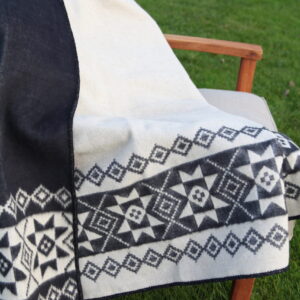Dimensions 145 x 200 cm
70% cotton, 30% flax
In South Estonia, festive woollen rectangle wrap, worn across one’s shoulders, was the most respectable garment. In Paistu, even on the 19th century oblong woollen shawls were worn. White shawl was decorated by using archaic techniques and patterns that had a deep meaning. South Estonian scarf is inspired by Paistu apron, where cross (symbol of balance; possesses a protective meaning), circle (symbol of infinity, perfection and harmony) and thuja (symbol of conception and fertility) can be seen. Such shawls were only worn by adult women.





